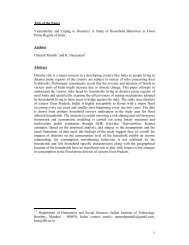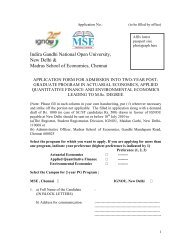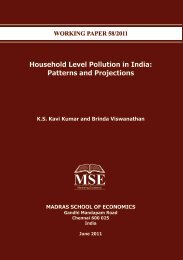Discount Rate for Health Benefits and the Value of Life in India
Discount Rate for Health Benefits and the Value of Life in India
Discount Rate for Health Benefits and the Value of Life in India
Create successful ePaper yourself
Turn your PDF publications into a flip-book with our unique Google optimized e-Paper software.
METHODOLOGY<br />
This study utilizes <strong>the</strong> LC model developed <strong>in</strong> Moore <strong>and</strong> Viscusi (1990),<br />
which specifies <strong>the</strong> expected discounted lifetime utility <strong>of</strong> a worker with T<br />
years <strong>of</strong> rema<strong>in</strong><strong>in</strong>g life who discounts future utilities at r <strong>and</strong> selects a job<br />
with risk p as 4 :<br />
T(p)<br />
V = ∫ U<br />
0<br />
1 (Y(p)) e -rt dt (1)<br />
The worker’s problem is <strong>the</strong>n to choose p <strong>in</strong> order to maximize<br />
his/her expected discounted lifetime utility V. From <strong>the</strong> first order<br />
condition <strong>for</strong> a maximum, <strong>the</strong> follow<strong>in</strong>g equation can be derived:<br />
∂Y/∂p = -r (∂T/∂p) (U(.)/U Y ) [e rT(p)<br />
– 1] -1<br />
In (2) <strong>the</strong> left side is <strong>the</strong> worker’s marg<strong>in</strong>al rate <strong>of</strong> substitution<br />
between <strong>the</strong> current period wages <strong>and</strong> job risk that depends upon <strong>the</strong><br />
expected rema<strong>in</strong><strong>in</strong>g time (T), <strong>the</strong> discount rate (r) <strong>and</strong> <strong>the</strong> effect <strong>of</strong> risk<br />
on longevity (∂T/∂p). Tak<strong>in</strong>g logarithms on both sides <strong>of</strong> <strong>the</strong> equation (2)<br />
yields:<br />
ln (∂Y/∂p) = αi - rT + ε (3)<br />
where ε captures errors <strong>in</strong> <strong>the</strong> approximation: ln (e rT -1) -1 ≈ -rT<br />
<strong>and</strong> <strong>the</strong> term, αi (= ln (-r*∂T/∂p*U/UY) can be approximated by a<br />
vector Z that <strong>in</strong>corporates proxies <strong>for</strong> differences <strong>in</strong> tastes. The estimated<br />
r will give a direct estimate <strong>of</strong> <strong>the</strong> worker’s rate <strong>of</strong> time preference.<br />
4 The model assumes that <strong>the</strong> worker’s state-dependent/time separable preferences is U j (Y j ), where<br />
Y j is <strong>in</strong>come <strong>in</strong> state j=1,2 (<strong>in</strong> no accident state 1, worker i is healthy <strong>and</strong> earns a wage Yi that<br />
<strong>in</strong>creases with p <strong>and</strong> <strong>in</strong> risky/accidental state 2, worker dies <strong>and</strong> earns no wage) <strong>and</strong> <strong>the</strong> worker’s<br />
time horizon equals his/her expected rema<strong>in</strong><strong>in</strong>g lifetime, T that depends on p with longevity a<br />
decreas<strong>in</strong>g function <strong>of</strong> p (i.e., Tp< 0).<br />
7<br />
(2)



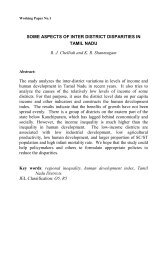
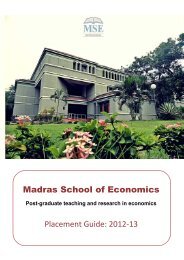
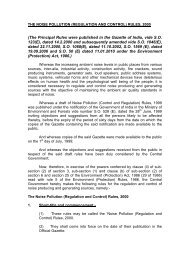
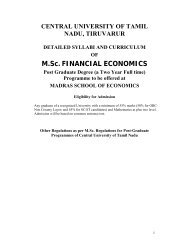
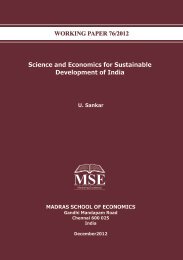
![Curriculum Vitae [pdf] - Madras School of Economics](https://img.yumpu.com/49878970/1/190x245/curriculum-vitae-pdf-madras-school-of-economics.jpg?quality=85)
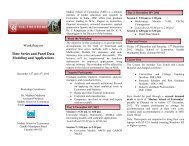
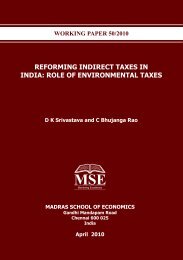
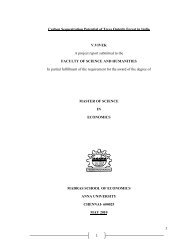
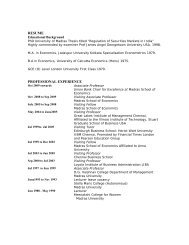
![Curriculum Vitae [pdf] - Madras School of Economics](https://img.yumpu.com/48715201/1/184x260/curriculum-vitae-pdf-madras-school-of-economics.jpg?quality=85)
